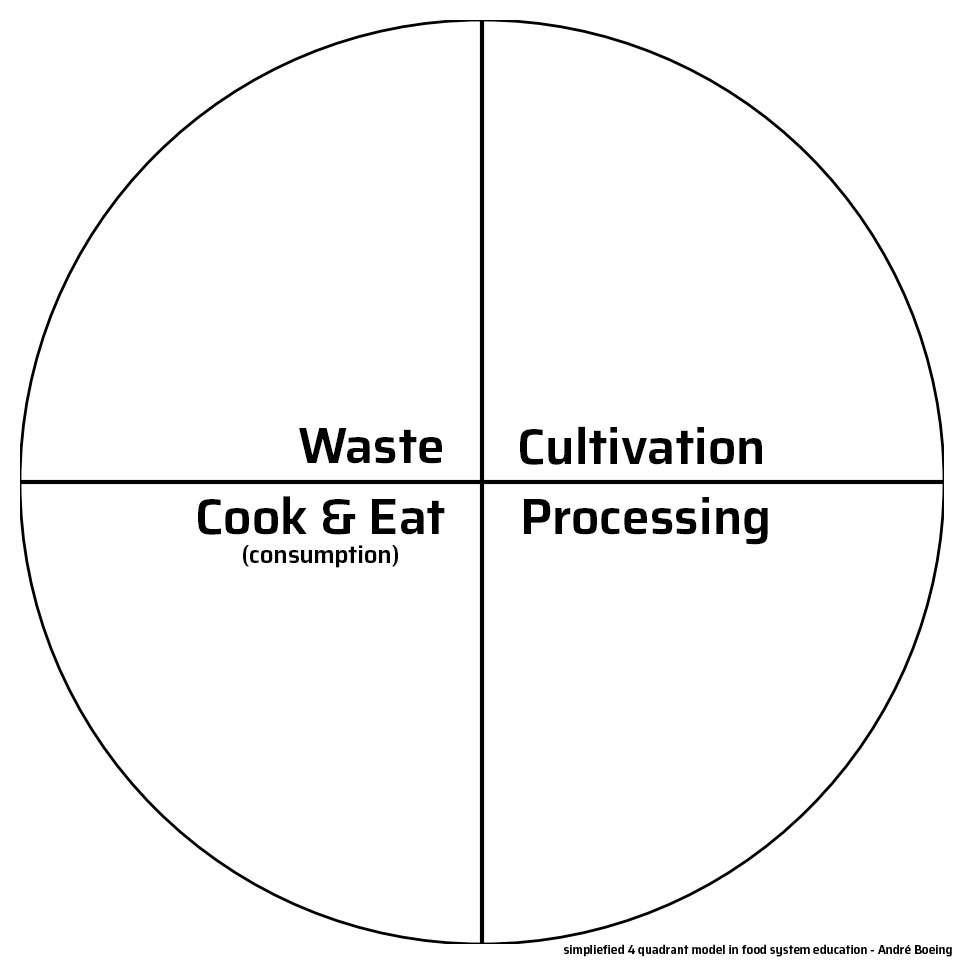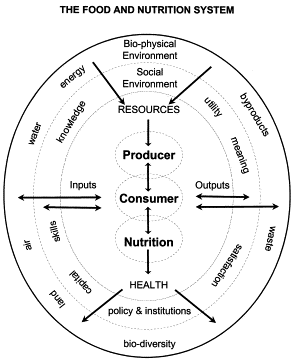Theoretical overview and key findings from 18 research papers in the study of food systems
André Boeing, January 15th 2024
The concept of food systems encompasses a broad spectrum of activities and contexts, ranging from basic production and processing to advanced integration into urban planning and smart city designs.
This page provides a succinct overview of food systems across three distinct but interconnected domains: general food systems, food systems in city regions and food systems within smart eco-cities. Each section offers a summary of key findings from recent research papers, highlighting the evolving nature of food systems and their growing importance in sustainable urban development.
Foreword
My proposal for a simplified 4 quadrant model of integrated food systems in the educational context of the ktopia project resulted from the complexities and layers I found in the theoretical studies and CRFS Frameworks. Although of immense value in policy making, process design and science, complex models are challenging in communicating to a diversity of people in participatory citizen food system projects.

One, where it all grows. One, where it is being processed. One where it is being cooked and eaten and one where all the waste goes. Cultivation > Processing > Cook & Eat (consumption) > Waste. This model can be explained on one hand with the thumb touching the other fingers. It is simple enough to use in food systems education and inclusive participation from pre-school to the many diverse actors in city regions.
Taking “A conceptual model of the food and nutrition system” from J. Sobal, L. Khan and C. Bisogni from 1998 as a foundation to illustrate the complexity.

“Four major types of models were identified: food chains, food cycles, food webs and food contexts. The integrated model developed included three subsystems (producer, consumer, nutrition) and nine stages (production, processing, distribution, acquisition, preparation, consumption, digestion, transport, metabolism).
The integrated model considers the processes and transformations that occur within the system and relationships between the system and other systems in the biophysical and social environments. The integrated conceptual model of the food and nutrition system presents food and nutrition activities as part of a larger context and identifies linkages among the many disciplines that deal with the food and nutrition system.”
(Sobal, Khan, & Bisogni, 1998)
To further deepen the understanding of food systems and application in our city region Kassel, Germany I created this research page as a basic overview separated into 3 sections with 6 key findings from research papers.
André Boeing, January 2024, Kassel
1. Food System in the general context
Conceptual Framework of Food Systems
Food and nutrition activities are part of a larger context, with subsystems including production, processing, and consumption. This integrated model considers the relationships between these activities and the biophysical and social environments (Sobal, Khan, & Bisogni, 1998)
Rapid Transformation in Developing Regions
Food systems in developing regions have undergone rapid transformations, largely influenced by agricultural research and innovations. These changes have significant impacts on consumers, farmers, and the overall efficiency and sustainability of the food chain (Reardon et al., 2019).
Sustainability and Vulnerability
Sustainable food systems are critical for addressing environmental, economic, and social challenges. A model that articulates the vulnerability and resilience factors to global changes can guide policy towards sustainability and improved food and nutrition security (Allen & Prosperi, 2016).
Environmental Impacts and Limits
The food system is a major driver of environmental challenges, including climate change and resource depletion. A combination of measures, including dietary changes and improvements in technology, is necessary to mitigate these impacts and keep the system within planetary boundaries (Springmann et al., 2018)
Biomass Metabolism and Resource Efficiency
The food system significantly influences the biogeochemical cycles of carbon, water, and nitrogen. Understanding the total turnover of biomass and resource efficiency is crucial for assessing the environmental impacts of the food system (Wirsenius, 2003).
Role of Agricultural Biodiversity
Agricultural biodiversity is essential for the resilience of traditional food systems and global food security. It plays a key role in balancing diet diversity, health, and sustainable economic growth (Johns et al., 2013).
In conclusion, food systems are multifaceted and critical for global well-being, requiring integrated approaches to ensure their sustainability, efficiency, and resilience in the face of environmental and socio-economic challenges.
2. Food System in the context of city regions
Food systems within city regions, also known as City Region Food Systems (CRFS), are increasingly recognized as vital for enhancing urban food security and sustainability, especially in the face of challenges like urbanization, climate change, and socio-economic disparities. The following points provide a comprehensive overview of the current understanding and initiatives related to CRFS:
Smart City Planning and Urban Food Systems
The integration of smart city planning with urban food systems can promote flexible and inclusive governance models, emphasizing technological and social innovations tailored to specific city-region contexts (Maye, 2019).
Integration of Urban and Rural Development
The CRFS approach supports local governments and policymakers in making informed decisions to improve urban and regional food system sustainability, taking into account the integration of urban and rural areas. Case studies from Latin America highlight policy uptake and territorial food planning (Dubbeling et al., 2017).
Resilience During Pandemics:
The resilience of city-region food systems during crises, such as the COVID-19 pandemic, is crucial. The case of the Paris-Rungis market illustrates the importance of collaborative supply chain resilience, including partnerships, digitization, and multi-stakeholder control (Thiesset & Vlachos, 2022).
Building Resilience to Shocks
A CRFS approach can contribute to regional sustainability and resilience to shocks like COVID-19 and climate change. Key entry points include multistakeholder engagement, robust infrastructure support, system-centered planning, and effective policy implementation (Blay-Palmer et al., 2021)
Inclusive and Transformational CRFS
A critical assessment of the CRFS approach suggests its potential in addressing complex challenges like integrated governance, territorial development, metabolic flows, and climate change, thereby contributing to sustainable food systems (Blay-Palmer et al., 2018).
Foodscapes in Rapidly Urbanizing Regions
An exploration of Dar es Salaam’s foodscape reveals that staple foods are sourced from rural hinterlands through a food system that represents a working alternative to the global corporate food system (Wegerif & Wiskerke, 2017)
In conclusion, city-region food systems play a crucial role in addressing the sustainability, resilience, and equity challenges of urban food security. This requires a collaborative and integrative approach involving various stakeholders, innovative practices, and effective policy frameworks.
3. Food System in the context of smart eco cities
In the context of smart eco-cities, food systems are increasingly being integrated with advanced technologies and innovative approaches to create sustainable, efficient, and resilient urban environments. Here are some key insights from recent studies:
Smart City Planning and Urban Food Systems
The integration of smart city planning with urban food systems can promote flexible and inclusive governance models, emphasizing technological and social innovations tailored to specific city-region contexts (Maye, 2019).
Digital Communication in Food Environments:
Digital technologies can enable participation of all residents, including the food insecure, in co-designing sustainable and inclusive food environments. This approach, known as ‘hacking the foodscape,’ involves engaging eaters in the co-design of local foodscapes or places related to food activities (Mann, 2020).
IoT for Urban Agriculture and Precision Applications:
Internet of Things (IoT) technology is crucial for automating and providing intelligence to urban agriculture, especially in smart cities. The IoT architecture can enable efficient automation of urban farming and precision agronomy, contributing to sustainable food production within cities (Ordoñez-García et al., 2017).
Integrating Urban Food Systems into Smart City Policymaking:
This study explores the integration of urban agri-food systems into smart city policies. It discusses approaches to democratizing smart city concepts with a focus on market and non-market activities, including forms of urban activism pursuing urban food systems in Australia and Germany (Dela Cruz et al., 2019).
Sensor Data Collection in Smart City Food Supply Chains
IoT systems in smart cities can monitor, analyze, and manage food industries, improving efficiency and accuracy of food provenance. This approach can significantly enhance food safety and traceability in urban areas (Zhang et al., 2013).
Foodscapes in Rapidly Urbanizing Regions
An exploration of Dar es Salaam’s foodscape reveals that staple foods are sourced from rural hinterlands through a food system that represents a working alternative to the global corporate food system (Wegerif & Wiskerke, 2017)